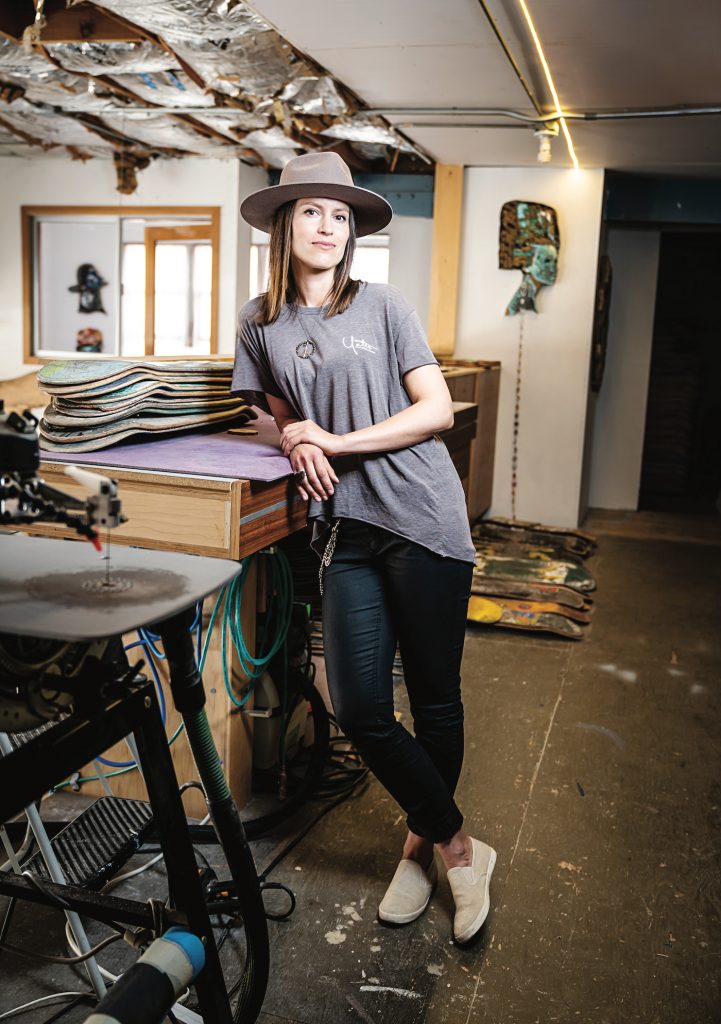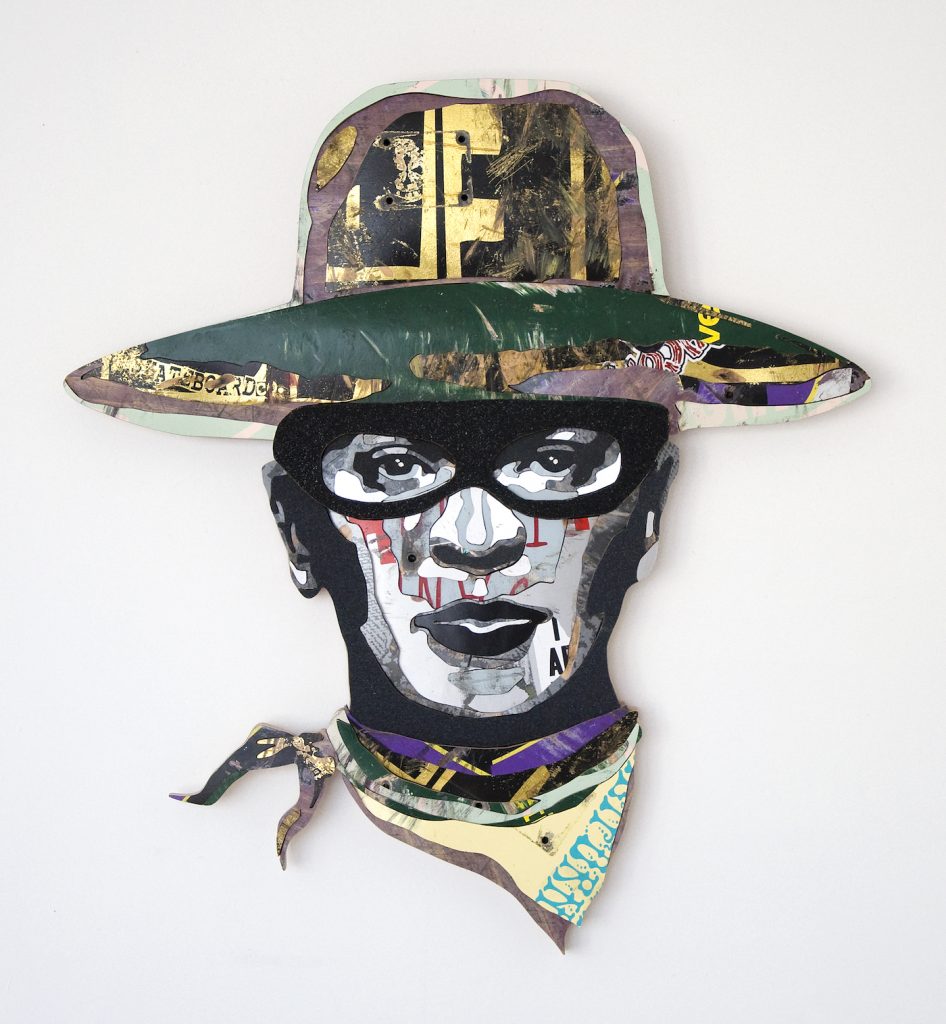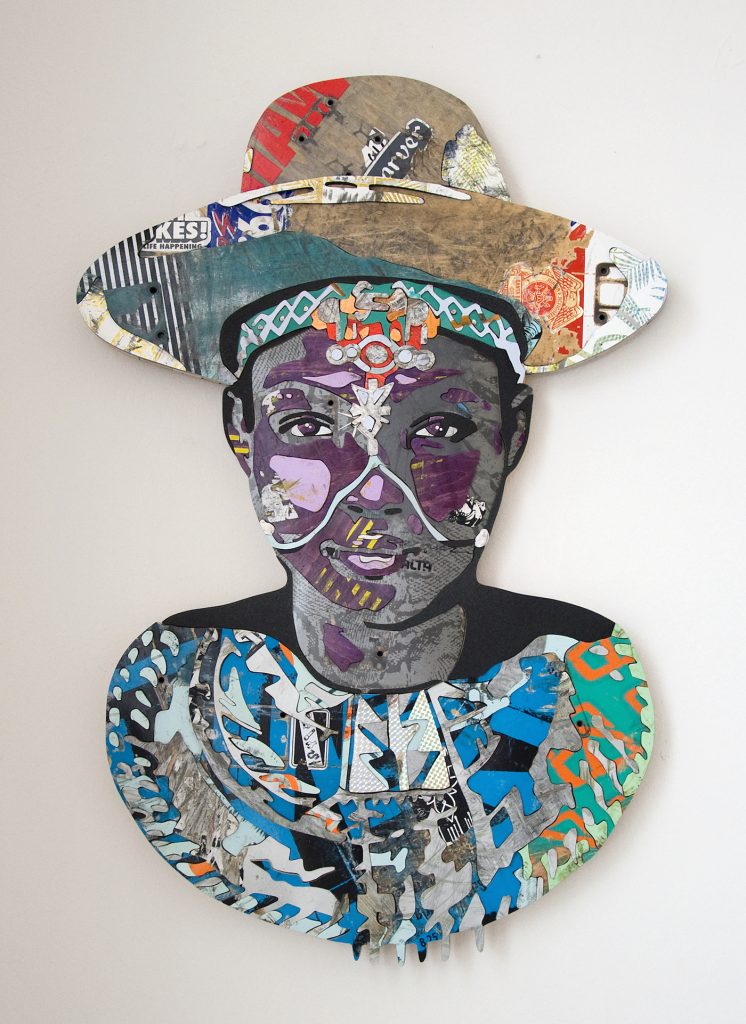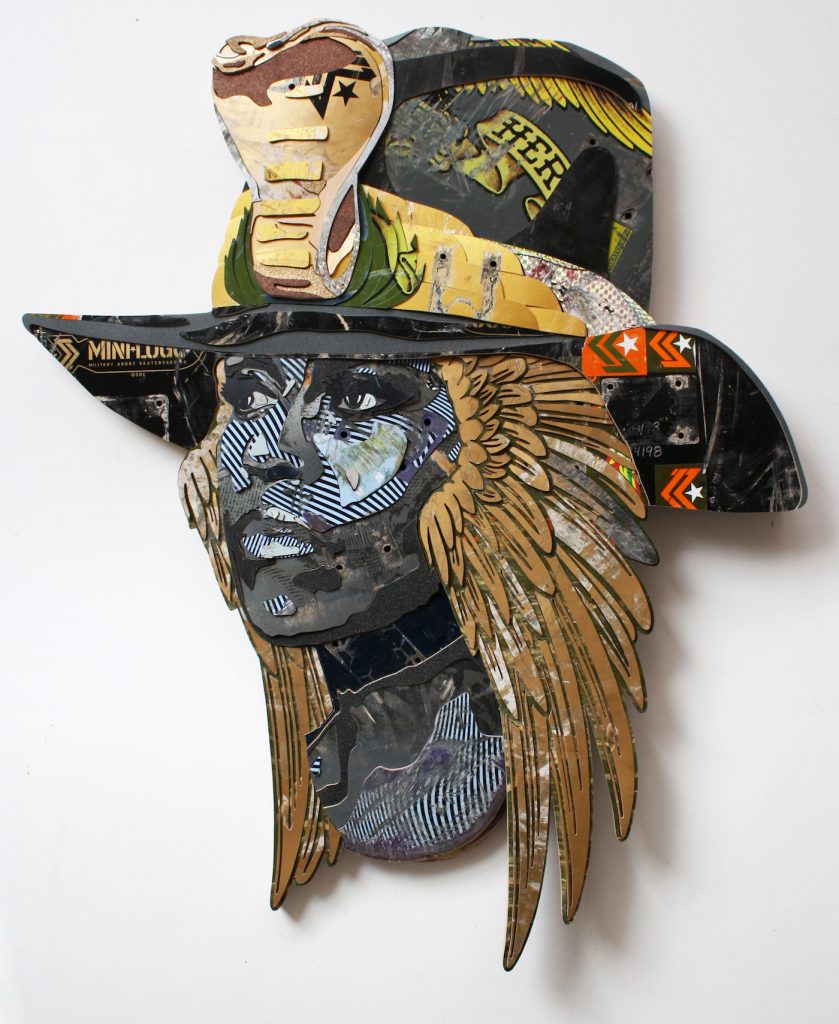A Rebel will Rise

Artist Inga Guzyte is lucky. She’s been able to turn her three obsessions – skateboarding, art, and woodworking – into a career that is growing step by giant step.
“It’s the perfect recipe,” she says.
Her current solo show that opens at Sullivan Goss June 6 is one of those giant steps. “Rebels” is both a feminist statement and an artistic one, portraits done in her intricate layered skateboard style of influential women from Frida Kahlo to Alexandria Ocasio-Cortez, activists like Malala Yousafzai, and popular political figures Michelle Obama and Ruth Bader Ginsburg. She has placed them in fabulous headdresses, or has them wearing hats similar to the one she often wears – it’s become her trademark – and some have their face hidden by bandanas, bandit-style. They share some of their DNA with fellow artist and friend David Flores, but Guzyte’s new work is even more intricate and complex.
I talked with Guzyte at the woodworking studio on lower Gutierrez that she has shared with her carpenter husband of seven years. It’s a large, airy place with the smell of fresh sawdust, populated with great industrial belt-sanders and band saws, with a web of metal piping rising up into the ceiling. Guzyte works mostly upstairs on just a few machines that use the thinnest blades available, sharp-toothed, and the size of pencil lead.

“I go through about five of these per piece,” she says. Along the wall she has stacked used skateboards, her raw material, sorted and color coded. Modern skateboards are a sandwich of maple wood layers, a relatively hard wood that the jigsaw has no problems slicing through. And when she finishes cutting out each piece, the edges are pretty well sanded and smooth due to the fine blade.
(Guzyte briefly fires up the saw and demonstrates by cutting out a minute curved piece on some spare wood. Her fingers seem dangerously close to the blade, but what do I know? She cuts with confidence.)
Guzyte’s pieces come together using marquetry, the technique of making wood mosaics. Because the skateboards all come used, she embraced all their imperfections, from scuff-marks to logos, as well as using broken, shattered edges. However, grip tape gets peeled away using a hot air gun. Finished pieces have a collage-type feel.
“I like to keep some stickers on the boards,” she says. “I don’t want everything to be my choice.”
Asked about her feminism and her politics, Guzyte says it’s been less a conscious choice and more that she’s wound up there because of society. As she started to assert herself as an artist, she says, she had people telling she wasn’t good enough or strong enough, and maybe most cutting of all, people here doubting that a woman could even do woodwork. That includes other women: “I had a show in L.A. and a lady wanted to meet the artist. I came down and she was like, ‘Who are you?’ She wasn’t expecting another woman… In Europe it’s not uncommon to meet a female woodworker. But when I came over here, [male] woodworkers were very impressed.” (Her inflection indicates a condescending male voice).


Guzyte grew up in a small village in Lithuania during the last years of the Soviet Union.
“I was told by my mom that my dad never wanted a girl,” she says, as we sit in her gallery next to her workshop. “He told my mom if he didn’t give her a boy he would leave.” He left regardless – Guzyte knows the argument was a crock. But that meant her mom struggled to raise her and her brother and so they took off to Germany when Inga was 11.
“It had an impact on me. I see so many dads who are so proud of their daughters, and it always warms my heart.” Moving away from Lithuania made her sad, but she knows now this was the best decision. She made friends, teachers were encouraging, and by the time she was old enough to graduate high school, she was looking to America. At the same time she was getting into skateboarding.
“I had so many options of where to go, and I chose Santa Barbara, almost blindly,” she says. “It was a small town, it looked easy to get around.”
And though she attended an ESL school downtown, where she really learned to speak English, she says, was at the Cabrillo skatepark.
“I spent so much time there and I was just trying to talk to people and learn all the slang,” she said. Guzyte had picked up skateboarding in Germany, but felt she had started too late. The skatepark was an excellent opportunity to catch up.
After that first round in Santa Barbara, she returned to Germany and then back to Santa Barbara City College with a plan: to take art classes.
“That blew my mind,” she remembers, “that’s when I saw what art could be.”
Her two favorite teachers were printmaker Stephanie Dotson and sculptor Ed Inks.
“Suddenly I had all these tools and materials,” she says. “And I kept asking myself what would be my medium. I had all these skateboards laying around, so I started cutting them and gluing them together.”
Her earliest pieces were cartoony, and would not be out of place on an animated Nickelodeon show. Guzyte was learning her craft on less delicate machines than she uses now, and there was a more basic geometry to her choices. But still: the first pieces she made she sold, she remembers, to a SBCC teacher. As she has progressed, the printmaking influence has come back into the work with a force, not just in the pop-art style, but even in how she conceives of the works.
Guzyte knows that she will be working on these Rebels pieces right up until the show. And, she says, beyond.
“I feel like this series could be endless. There are a lot of rebels.”







